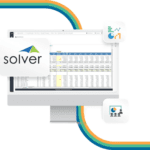Forecasting & Financial Modelling Techniques, and Key Driver Analysis
By Access Analytic
These two key topics were the subjects of presentations by Access Analytic Principal Business Analyst, Jeff Robson, during June’s ‘2013 CPA Week’ in Brisbane.
Successful forecasting – predicting or estimating the future based on past and present data – is fundamental to business success.
Similarly, non-financial KPIs: Key Drivers, are critical.
To quote Deloitte, Canada:
“External stakeholders look at a range of non-financial performance measures to assess how well a company is meeting its corporate responsibility objectives. These are seen as a proxy for good management. To communicate this information, companies require relevant non-financial key performance indicators, or KPIs.”
Solving the forecasting conundrum – balancing need with uncertainty
Robust forecasts should use valid statistical techniques to analyse both past and present data. However, despite following well-established forecasting methodologies, many management professionals still end up asking themselves: “Why are my forecasts always wrong?”
Jeff’s presentation outlined a number of salient forecasting factors.
For a start, forecasting carries with it an intrinsic degree of subjectivity. The butterfly effect of chaos theory can also come into play, where a small change in one forecasting variable in a non-linear model can result in significantly altered forecast outcomes.
All forecasting models have limitations. These can be reduced, but it can be time-consuming, highly technical and costly to do so.
Forecasts are estimates only, and the longer the forecast term, the less accurate they’re likely to be. The underlying assumptions could be wrong or over-simplified. Quite simply, the past may not predict the future in all cases, and forecasting is inevitably subject to the forecaster’s bias, potential human error, and a tendency to be over confident in the validity of the results.
However, despite the challenges in achieving them, robust, reliable forecasts are an indispensible management tool.
Forecasting is necessary for planning and decision-making, and focuses management on the future and strategies to achieve corporate goals. Good forecasts provide confidence and can handle uncertainty by examining various future scenarios.
Forecasting Types
Forecasting falls into two types:
- Qualitative forecasting is more subjective, judgement-based, and uses opinion and gut-feel. This approach is more about making medium to long-term decisions;
- Quantitative forecasting uses forecasting models to analyse historical data. It is more objective and generally appropriate to short to medium-term decisions and strategies.
Access Analytic’s Excel expertise helps it design quantitative forecasting methodologies that use a range of techniques, including moving averages; which can be simple, cumulative or weighted.
Extrapolation and trend analysis can be extremely useful, as can regression analysis, which helps you understand how the value of a dependent variable changes when any one of the independent variables is varied, while the other independent variables are held fixed.
Excel 2016 now includes a number of great new forecasting functions and charting options that really help with this area.
Access Analytic takes an approach of using scenarios and sensitivities to consider potential outcomes, and utilising interim or rolling forecasts to constantly refine decision-making, planning and strategy development.
Advanced expertise with Excel functions such as the ‘what-if analysis’ tools Goal Seek and Solver can make optimising values in a spreadsheet to meet a given objective a much less arduous process, and forecasting of various scenarios more achievable with less time and effort.
Find out More
Simply contact Principal Business Analyst Jeff Robson on +61 8 621 8500 or +61 412 581 486 or leave your details below for a confidential discussion.








